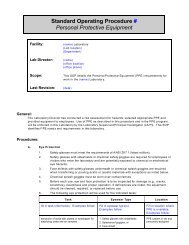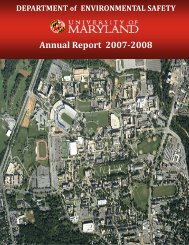PACKING INSTRUCTION 650
PACKING INSTRUCTION 650
PACKING INSTRUCTION 650
You also want an ePaper? Increase the reach of your titles
YUMPU automatically turns print PDFs into web optimized ePapers that Google loves.
® Packing Instructions — Class 6 — Toxic and Infectious<br />
Substances<br />
<strong>PACKING</strong> <strong>INSTRUCTION</strong> <strong>650</strong><br />
STATE VARIATIONS: BHG-02 CAG-05 DQG-03 FRG-06 GBG-05 VCG-04<br />
� OPERATOR VARIATIONS: AF-04 AS-08 BR-14 CI-01 CO-07 CS-07 FX-09<br />
IJ-06 JJ-06 JK-03 KE-06 LA-07 LH-12 MN-03 MS-03 MX-06 MX-11 PX-08 SQ-<br />
10 TK-08 UU-05 XK-02<br />
This instruction applies to UN 3373 on passenger and cargo aircraft and CAO.<br />
General Requirements<br />
The packagings must be of good quality, strong enough to withstand the shocks<br />
and loadings normally encountered during transport, including trans-shipment<br />
between transport units and between transport units and warehouses as well as<br />
any removal from a pallet or overpack for subsequent manual or mechanical<br />
handling. Packagings must be constructed and closed so as to prevent any loss<br />
of contents that might be caused under normal conditions of transport, by<br />
vibration, or by changes in temperature, humidity or pressure.<br />
The packaging must consist of three components:<br />
(a) a primary receptacle(s);<br />
(b) a secondary packaging; and<br />
(c) a rigid outer packaging.<br />
Primary receptacles must be packed in secondary packagings in such a way<br />
that, under normal conditions of transport, they cannot break, be punctured or<br />
leak their contents into the secondary packaging. Secondary packagings must be<br />
secured in outer packagings with suitable cushioning material. Any leakage of<br />
the contents must not compromise the integrity of the cushioning material or of<br />
the outer packaging.<br />
Packages must be prepared as follows:<br />
(a) For liquid substances:<br />
• The primary receptacle(s) must be leakproof and must not contain<br />
more than 1 L;<br />
• The secondary packaging must be leakproof;<br />
Page 1 of 5
• If multiple fragile primary receptacles are placed in a single<br />
secondary packaging, they must be either individually wrapped or<br />
separated to prevent contact between them;<br />
• Absorbent material must be placed between the primary receptacle<br />
and the secondary packaging. The absorbent material, such as<br />
cotton wool, must be in sufficient quantity to absorb the entire<br />
contents of the primary receptacle(s) so that any release of the<br />
liquid substance will not compromise the integrity of the cushioning<br />
material or of the outer packaging;<br />
• � The primary receptacle or the secondary packaging must be<br />
capable of withstanding, without leakage, an internal pressure of<br />
95 kPa in the range of -40°C to 55°C (-40°F to 130°F).<br />
Note:<br />
� The capability of a packaging to withstand an internal pressure<br />
without leakage that produces the specified pressure differential<br />
should be determined by testing samples of primary receptacles or<br />
secondary packagings. Pressure differential is the difference<br />
between the pressure exerted on the inside of the receptacle or<br />
packaging and the pressure on the outside. The appropriate test<br />
method should be selected based on receptacle or packaging type.<br />
Acceptable test methods include any method that produces the<br />
required pressure differential between the inside and outside of a<br />
primary receptacle or a secondary packaging. The test may be<br />
conducted using internal hydraulic or pneumatic pressure (gauge)<br />
or external vaccum test methods. Internal hydraulic or pneumatic<br />
pressure can be applied in most cases as the required pressure<br />
differential can be achieved under most circumstances. An external<br />
vacuum test is not acceptable if the specified pressure differential<br />
is not achieved and maintained. The external vacuum test is a<br />
generally acceptable method for rigid receptacles and packagings<br />
but is not normally acceptable for<br />
– flexible receptacles and flexible packagings<br />
– receptacles and packagings filled and closed under a<br />
absolute atmospheric pressure lower than 95 kPa<br />
• The outer packaging must not contain more than 4 L. This quantity<br />
excludes ice, dry ice or liquid nitrogen when used to keep<br />
specimens cold.<br />
(b) For solid substances:<br />
• The primary receptacle(s) must be siftproof and must not exceed<br />
the outer packaging weight limit;<br />
• The secondary packaging must be siftproof;<br />
Page 2 of 5
• If multiple fragile primary receptacles are placed in a single<br />
secondary packaging, they must be either individually wrapped or<br />
separated to prevent contact between them;<br />
• Except for packages containing body parts, organs or whole<br />
bodies, the outer packaging must not contain more than 4 kg. This<br />
quantity excludes ice, dry ice or liquid nitrogen when used to keep<br />
specimens cold;<br />
• If there is any doubt as to whether or not residual liquid may be<br />
present in the primary receptacle during transport then a packaging<br />
suitable for liquids, including absorbent materials, must be used.<br />
� An itemized list of contents must be enclosed between the secondary<br />
packaging and the outer packaging.<br />
At least one surface of the outer packaging must have a minimum dimension of<br />
100 mm x 100 mm (4 in x 4 in).<br />
� The completed package must be capable of successfully passing the drop<br />
test described in 6.6.1 except that the height of the drop must not be less than<br />
1.2 m. Following the appropriate drop sequence, there must be no leakage from<br />
the primary receptacle(s) which must remain protected by absorbent material,<br />
when required, in the secondary packaging.<br />
� For transport, the mark illustrated below must be displayed on the external<br />
surface of the outer packaging on a background of a contrasting colour and must<br />
be clearly visible and legible. The mark must be in the form of a square set at an<br />
angle of 45°(diamond-shaped) with each side having a length of at least 50 mm<br />
(2 in), the width of the line must be at least 2 mm and the letters and numbers<br />
must be at least 6 mm high. The proper shipping name “Biological Substance,<br />
Category B” in letters at least 6 mm high must be marked on the outer package<br />
adjacent to the diamond-shaped mark.<br />
� Unless all package markings are clearly visible, the following conditions apply<br />
when packages are placed in an overpack:<br />
• the overpack must be marked with the word “Overpack”; and<br />
• the package markings must be reproduced on the outside of the overpack.<br />
Page 3 of 5
A Shipper's Declaration for Dangerous Goods is not required.<br />
Specific Requirements<br />
Refrigerated or frozen specimens: Ice, dry ice and liquid nitrogen:<br />
• When dry ice or liquid nitrogen is used to keep specimens cold, all<br />
applicable requirements of these Regulations must be met. When used, ice<br />
or dry ice must be placed outside the secondary packagings or in the outer<br />
packaging or an overpack. Interior supports must be provided to secure the<br />
secondary packagings in the original position after the ice or dry ice has<br />
dissipated. If ice is used, the outside packaging or overpack must be<br />
leakproof. If dry ice is used, the packaging must be designed and<br />
constructed to permit the release of carbon dioxide gas to prevent a buildup<br />
of pressure that could rupture the packagings.<br />
• The primary receptacle and the secondary packaging must maintain their<br />
integrity at the temperature of the refrigerant used as well as the<br />
temperatures and the pressures, which could result if refrigeration were to<br />
be lost.<br />
� Infectious substances assigned to UN 3373 which are packed and marked in<br />
accordance with this packing instruction are not subject to any other requirement<br />
of these Regulations except for the following:<br />
(a) the name and address of the shipper and of the consignee must be<br />
provided on each package;<br />
(b) the name, and telephone number of a person responsible must be<br />
provided on the air waybill or on the package;<br />
(c) the classification must be in accordance to 3.6.2;<br />
(d) the incident reporting requirements in 9.6.1 must be met; and<br />
(e) the inspection for damage or leakage requirements in 9.4.1 and 9.4.2.<br />
Note:<br />
When the shipper or consignee is also the ‘person responsible’ as referred to in<br />
b) above, the name and address need be marked only once in order to satisfy<br />
the name and address marking provisions in both a) and b), above.<br />
Passengers and crew members are prohibited from transporting infectious<br />
substances as or in carry-on baggage, checked baggage or on their person.<br />
� � If an Air Waybill is used, the “Nature and Quantity of Goods” box should<br />
show “UN 3373” and the text “BIOLOGICAL SUBSTANCE, CATEGORY B”.<br />
Clear instructions on filling and closing such packages must be provided by<br />
packaging manufacturers and subsequent distributors to the shipper or to the<br />
person who prepares the package (e.g. patient) to enable the package to be<br />
correctly prepared for transport.<br />
Page 4 of 5
� Other dangerous goods must not be packed in the same packaging as<br />
Division 6.2 Infectious Substances unless they are necessary for maintaining the<br />
viability, stabilizing or preventing degradation or neutralizing the hazards of the<br />
infectious substances. A quantity of 30 mL or less of dangerous goods included<br />
in Classes 3, 8 or 9 may be packed in each primary receptacle containing<br />
infectious substances provided these substances meet the requirements of 2.7.1<br />
and 2.7.5. When these small quantities of dangerous goods are packed with<br />
infectious substances in accordance with this packing instruction, no other<br />
requirements in these Regulations need be met.<br />
Page 5 of 5
















